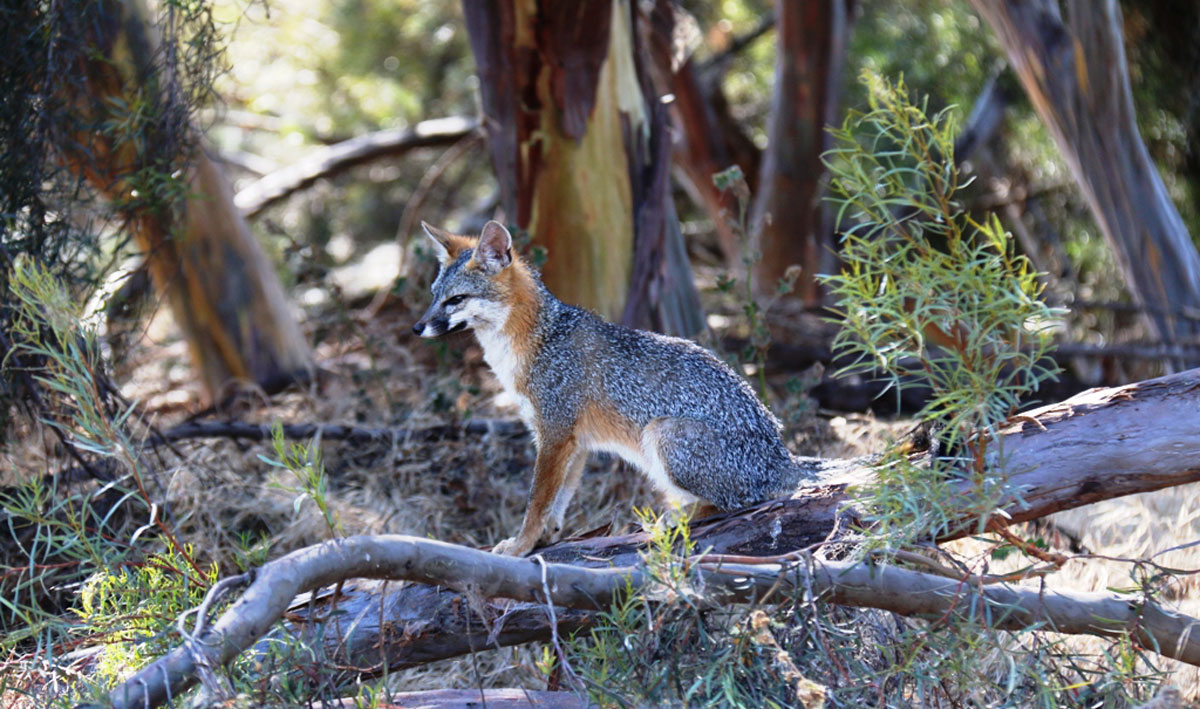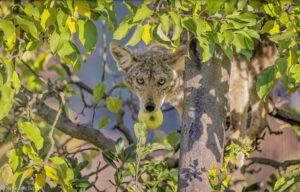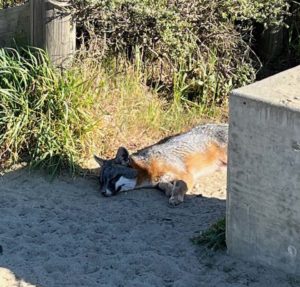The only noise in the 5 a.m. darkness is Bill Leikam, “The Fox Guy.” His shoes crunch down the partially paved dirt path, without even the noise of a car on the freeway that runs parallel to this piece of the Peninsula wetlands, or the noise of a single bird; it’s still too early, and the birds and commuters are all still asleep, in this transitional hour between night and day, and then Leikam calls out “Hey! Little fox!”
Bushes rustle; Leikam and wildlife photographer Greg Kerekes turn their headlights and catch the eyes of a gray fox, shining yellow white. The glow is low to the ground and the eyes close together, only a little taller off the ground than your typical house cat. If this wasn’t a natural area, a pocket of protected baylands near Palo Alto, it could be a cat.
“That fox, we’re in his territory now,” Leikam says. “He’s one of the few foxes I’ve actually seen that staunchly defends his territory.” One pair of eyes turns into two as another curious fox turns to examine us, and then a third — a female, and one of this year’s pups.
Recently, the Presidio Trust in San Francisco announced that a gray fox it first saw in January, the first recorded in San Francisco since 2004, had started a family. Which set me wondering about foxes in the Bay Area. Where are they? What are they? The answer to both questions is surprisingly complicated, and so I turned to The Fox Guy.
Leikam has given each fox in his Peninsula study area a name, and the foxes in turn know him; he’s been a regular visitor here for six years, coming twice a day almost every day. They approach within sniffing distance, though they keep clear of me, watching from the bushes. Leikam walks a few feet ahead and I hang back. The foxes follow us, darting in and out of cover, springing at prey we can’t see. Leikam keeps looking for more. “Hey! Little fox!”
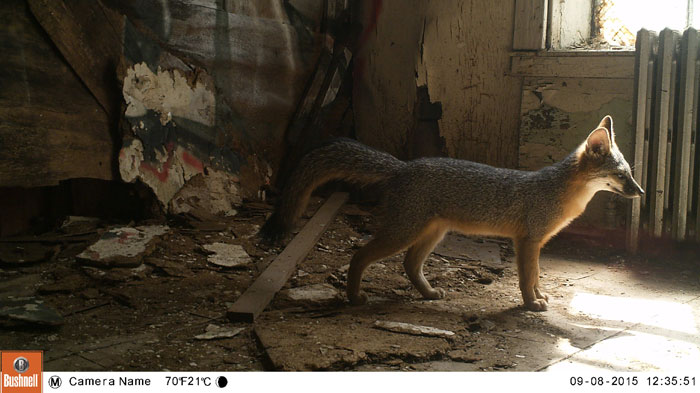
The gray fox, Urocyon cinereaoargenteus, and its closely related cousin the channel island fox, Urocyon littoralis, are the last living remnants of an ancient genus. “The gray fox occupies the earliest diverging branch on the canid tree of life,” says Ben Sacks, a biologist at UC Davis. “A gray wolf or your dog is as related to a gray fox as a red fox is, in terms of ancestry.”
Gray foxes are one of only two members of the Canidae family — the other is the Southeast Asian raccoon dog — that have the ability to climb trees, and do so regularly. A gray fox body is made for climbing, with claws that can hook into tree bark and help them climb straight up branchless trunks. They prefer to live in deciduous forests, while the better-known red fox is adapted to urban living. While gray foxes used to be common on the East Coast, urbanization has pushed them into more reclusive living. In the Bay Area, they’re still more commonly and easily seen than the red fox, though they seem to surprise people whenever they turn up.
Their surprise appearance is what drew Bill Leikam to them. He had seen the foxes as a child near his own Peninsula home, but it wasn’t until many years later, when he was retired and enjoying a hobby as a bird watcher, that they crossed his mind again. He saw three young foxes in the brush one morning, “and I kept coming back again and again, taking notes about what they were doing. I started a log.”
Leikam was surprised again to find that the nearest gray fox expert was at UC Davis — and that expert, Ben Sacks is careful to say that no one is truly an expert on the gray fox. Leikam took it on himself to note their behavior even more carefully and make himself a local expert, to answer questions that he’d had as a child. He now comes back frequently and keeps his logs religiously, posting status reports online for a growing legion of fox fans.
His observations have run the gamut of gray fox behavior, from the nuzzles they use to greet each other to the territorial behavior exhibited by males, including the fox that first greeted us. “He taught me a lot of what it means to be an alpha fox,” Leikam says. He’s also recorded communal pup raising between the high population concentration of foxes in the area. The National Wildlife Federation has dubbed Leikam ‘the Jane Goodall of the gray fox world,” for the behavior he’s witnessed and photographed, and the steps he’s taken in studying the animals.
He’s even observed little seen tree hunting behavior, and once captured it on film. While it’s known that the foxes climb trees, actually hunting among the foliage hasn’t been photographed or filmed frequently, making Leikam’s video a valuable contribution. In his video, an adult female Leikam has deemed “Cute” chased a black squirrel high into a tree. “She went for it and fell out of the tree,” he says with a laugh.
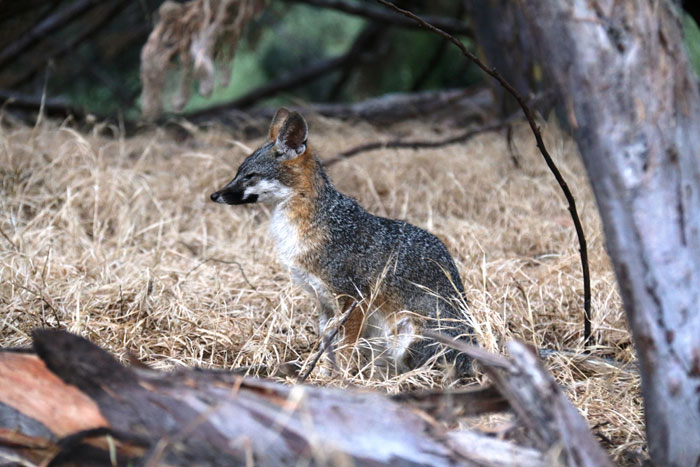
The sky lightens, and there are five foxes following us. We rest in a clearing where the foxes like to hang out in the heat of the day, nestled in a patch of scrubby woodland. Six foxes gather around, greeting each other nose to nose and watching us warily. That brings our total to nine foxes in a few hours, which seems remarkable, even crowded.
“Last year there were 27 adults and pups in a one and a half mile area,” Leikam says. A population like that isn’t sustainable, and the effects are already showing. Only three pups were born this year, and there appear to be only 10 adults hanging around. Leikam has a theory for that too. In lean times, coyotes can regulate the amount of young they give birth to, and he proposes that gray foxes may be capable of the same type of population regulation. It’s something he plans to study further.
Either way, the population booms and bottlenecks of the past have left a mark. Leikam has seen foxes malformed from inbreeding. “It was very serious four years ago, but this year I’ve only seen one fox who appears to only have two out of six breasts,” he says. “She couldn’t nurse her pup, and it died.”
The foxes need to expand their territory, and Leikam wants to help. He and Kerekes recently received a National Wildlife Foundation grant to track, monitor, and improve wildlife corridors throughout the Peninsula, so that the foxes can spread out. It’s a move that would benefit a large number of other species too, such as bobcats, that suffer from corridors that aren’t sufficiently protected.
So far, Leikam and Kerekes have plotted corridors from Redwood City to the Google headquarters in Mountain View, and have marked which need to be rehabilitated, mostly with new plants and an increase in brush to make animals more secure. Once they’ve determined where the other problem areas are, they plan to collar foxes and see where they disperse. While people have tracked corridors from the air, Leikam and Kerekes are the first ones to plot them extensively from a ground level. Many of the wildlife corridors run under nearby local freeways, including Highway 101 and Interstate 280, allowing animals safe passage across otherwise busy roads. Several of the corridors are badly neglected, stripped free of the necessary brush and leaving them so open that animals refuse to use them.
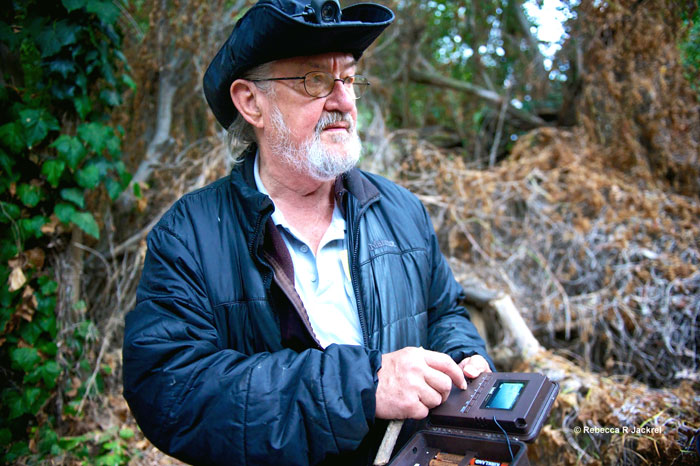
As Leikam checks one of the two camera traps he has in the area, the foxes begin to wander off. Our novelty has worn off, and the sun has fully risen. It’s time for them to do some last minute hunting and then go to sleep; they’re nocturnal, and will sleep until the sun starts to go down again. We leave them in their little clearing, and they don’t follow us back out.
Other people have started to appear. There’s a couple on the banks of the creek, just off the path. “They have a garden here,” Leikam says. “They grow things like beans.” This wild patch of land is, after all, a community place, and Leikam is very much about working with the community. He’s become a frequent consultant about fox visitors for local tech companies.
After one litter of pups died from secondary poisoning — ingesting a rat that has been poisoned — Leikam lobbied the Palo Alto City Council to ban the use of rodenticides and instead use a more eco-friendly method of rodent control: barn owls. One barn owl can take down six rodents a night — frequently more than would die from ingesting poison — and will provide a bonus to the health of the baylands overall.
The picture isn’t bleak. There is a Facebook Fox page, chronicling the extremely charismatic family of foxes living on the Facebook campus. Initially, Leikam says, Facebook contacted him to ask about getting rid of the foxes. The company feared bites, leading to liability issues, he says. “I told them the story about the London foxes,” Leikam says. “People in London were afraid when the red foxes started moving in. They were afraid the foxes would bite them. But they didn’t, and Londoners like their foxes now. People have to learn to live with them.”
Co-habitation led to the same. A fox club formed on the Facebook campus, which led in turn to the fan page, which has over 100,000 likes, extending the reach of the Peninsula’s gray foxes around the world. Just as people have to learn to live with foxes, though, Leikam says the foxes “have to learn to get along with human beings. There’s too many of us.”
Read more about Leikam and Kerekes’ National Wildlife Foundation grant here: http://blog.nwf.org/2015/09/meet-the-foxes-of-silicon-valley/

